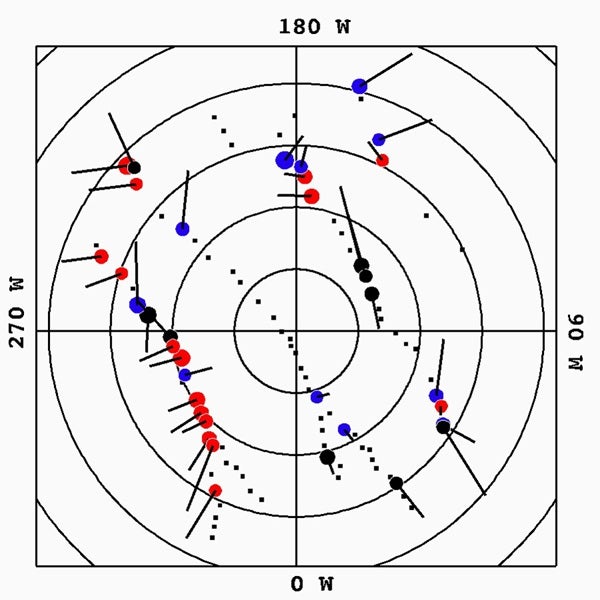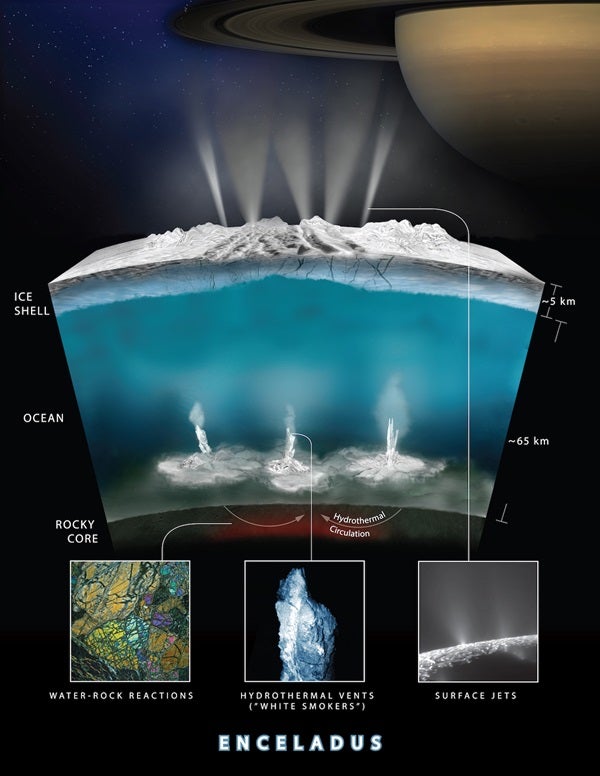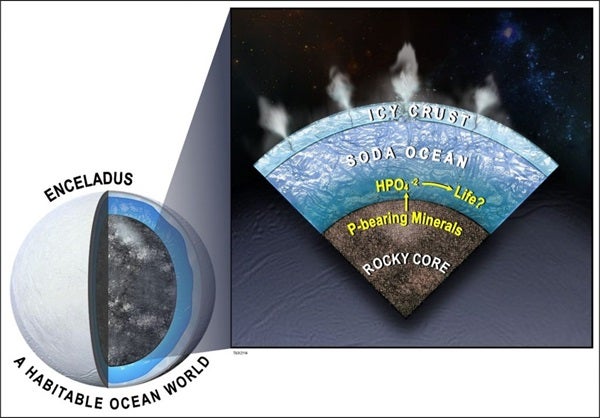In our solar system, Saturn’s moon Enceladus is unique: It provides scientists direct access to a global ocean hidden beneath the moon’s icy surface. That’s because Enceladus is constantly venting its subsurface water out into space.
Numerous geysers spew water vapor hundreds of miles into space through cracks that seem clawed into the moon’s south polar region. During its flybys, the Cassini spacecraft “tasted” some of the plumes, and its analysis indicated the water may have come from a carbonate-rich subsurface ocean.
A few of the plume’s contents — salty ice particles, ammonia, carbon monoxide, and other organic materials — strengthened the case for the potential habitability of Enceladus’ ocean. However, Cassini’s analysis did not reveal phosphorus, a key ingredient for life.
But now, a group of researchers have, for the first time, estimated the presence of a form of phosphorus called orthophosphate, which Earth life uses in many contexts. The researchers also found the phosphorus is both highly soluble and stable in Enceladus’s salty subsurface ocean.
The researchers published their findings Sept. 19 in the Proceedings of the National Academy of Sciences.
Evidence for phosphorus on Enceladus
The study’s authors performed geochemical modeling, constrained by Cassini data, to predict how much phosphorus could be present in Enceladus’ ocean. They found that the ocean water should be rather rich in dissolved phosphorus, lending credence to the notion that the moon’s subsurface ocean could be a habitable environment.
“The most interesting and promising aspect of this work is that the abundance of phosphorus may be quite high in the ocean of Enceladus — anywhere from 0.1 to 1000 times that of Earth’s oceans,” Manasvi Lingam, an assistant professor of astrobiology at Florida Institute of Technology who was not involved in the study, told Astronomy. “If so, the case for habitability (and life) on Enceladus gets stronger than before.”
The chemical reactions that generate the “energy currency” in cells and build RNA and DNA are crucial to the functioning of every living organism. And while these reactions require phosphorus, the mineral is relatively scarce in natural waters because it reacts with cations (positively charged atoms or molecules) such as calcium to form calcium phosphate. That reaction makes the phosphorus inaccessible for use by potential life.
The key to abundant availability of dissolved phosphorus in Enceladus’s ocean is that it “has a ‘soda’ ocean that is rich in sodium bicarbonate (baking soda),” Christopher Glein, a planetary scientist and geochemist at the Southwest Research Institute and one of the study’s authors, told Astronomy.
Soda lakes on Enceladus
Commonly known as soda lakes or oceans, carbonate-rich waters are great at letting phosphorus accumulate. That’s because carbonates are more prone to bond with calcium or other cations, forming carbonate or phyllosilicate minerals and leaving phosphorus available for life.
This geophysical phenomenon is seen on Earth, too, where soda lakes such as the Mono Lake in California have 50,000 times higher phosphorus levels than other waters. That abundant phosphorus supports complex ecosystems, including several species of fish, algae, and fungi.
“[Phosphorus] serves as a critical medium between solid Earth and its biosphere, as it is widely thought to control the level of biological production across a geological timescale,” Jihua Hao, a senior research scientist in China and one of the study’s authors, told Astronomy.
As to where the phosphorus on Enceladus came from, carbonaceous chondrite meteorites are a likely suspect. These remnant rocks date back to the formation of the outer solar system.
Our Sun has “an unusually high amount of [phosphorus] compared with nearby stars,” planetary astrophysicist Natalie Hinkel told Astronomy, “which has been beneficial for life on Earth.” And not surprisingly, stars, planets, moons, and meteoroids from the same stellar cloud often have similar compositions.
“If you look at how much [phosphorus] is in the most primitive carbonaceous chondrites and how much rock we think is inside Enceladus,” Glein told Astronomy, “the conclusion is that Enceladus should easily contain enough phosphorus feedstock to generate a relatively phosphorus-rich ocean.”
The habitability of Enceladus’ subsurface ocean
As important as phosphorus is, it’s only one piece of a fascinating puzzle when it comes to the habitability of Enceladus.
Sulfur, for example, is another important ingredient for life as we know it. But scientists are currently unsure how much sulfur is in Enceladus’ ocean, as well as the chemical forms it may take. The biggest obstacle in finding out, according to Glein, is limited data.
“We have a wonderful data set from Cassini, and folks are still searching for treasures in those data,” he says. “I think we still have some exciting discoveries that await us. In the long term, we are going to need more data to really understand Enceladus as a geochemical system — and, of course, to test for the presence of life.”
When the ocean trapped underneath Enceladus’ icy surface was first discovered, it added an intriguing option to the list of potential habitable environments where life could exist. Future missions would undoubtedly benefit from visiting the moon’s south polar region, where the plumes bursting through the surface provide unfiltered access to the subsurface ocean.
And fortunately, such a mission is already in the works: NASA’s Enceladus Orbilander. Currently a flagship mission concept with a stated launch in the late 2030s, Orbilander will focus on hunting for signs of life on Enceladus from orbit — at least at first.
According to NASA, Orbilander is eventually expected to land near the moon’s south pole shortly before 2052. Once there, it would scoop snow from the plumes that fell back to the surface. And testing that snow might just provide the first direct evidence of phosphorus on Enceladus.













